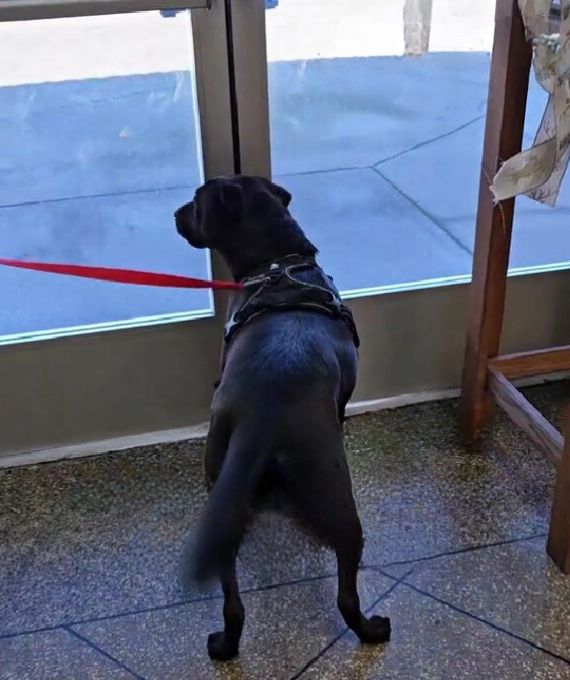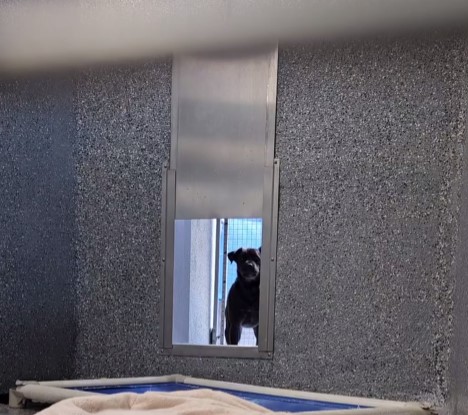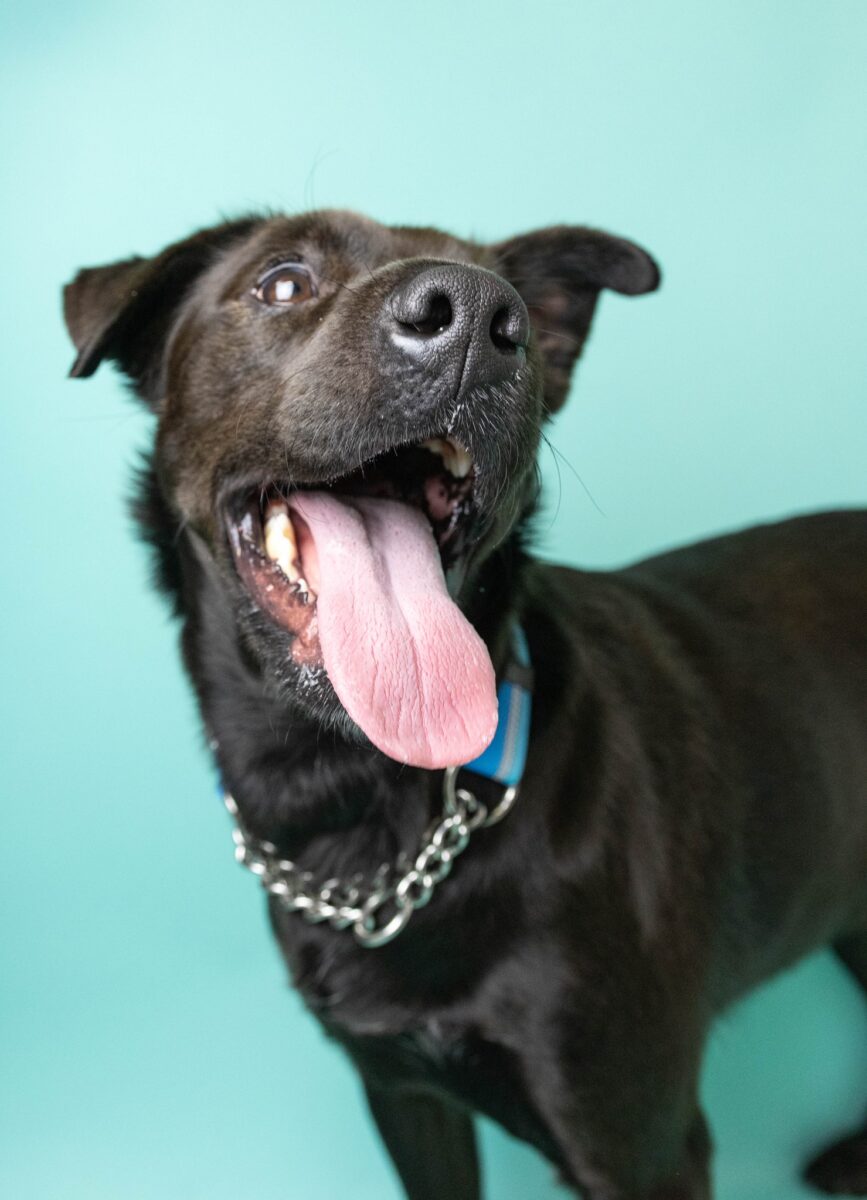Shelter is not a place for a dog, and we all know it. Unfortunately, not all of our furry friends are lucky enough to enjoy life in a warm home with a loving family.
Being in the shelter for just a few days is stressful for a canine, so you can only imagine how some dogs feel when they have to spend a lot more time between the four walls of a kennel.
One poor pup not only had to spend the majority of his time in that awful place, but he also had to experience three heartbreaks as he was returned to the shelter as many times.
The staff from the shelter in Fresno, California, decided to share his sad fate with their followers in the hope that someone would hear his cries.
So Many Heartbreaks

Although he had been everywhere during his lifetime, the Valley Animal Center in Fresno, California, was the only place Eros could call “home”. He actually had an owner before he first came to this shelter, but it wasn’t a pretty life.
“Eros came into our care as an agency transfer from a local animal control shelter,” Ruben Cantu, an animal care adoption supervisor at the shelter, told Newsweek. “From what was told to us by that shelter, he grew up in a homeless encampment, and never had a steady ‘home’ setting. His owner was unfortunately arrested, and Eros was taken by animal control.”
After the shelter took him in, it wasn’t long before he was adopted. The staff thought Eros was a lucky dog to find a home so quickly, but it was actually just one in a series of heartbreaks.
According to Cantu, the first adopter didn’t want him because of his high energy level and because they thought he was too hyper. A new adoption attempt soon followed, but unfortunately, it was again unsuccessful.

“His second home had a dog already in the home and even with training and our assistance the existing dog in the home would not accept Eros as a house mate and they felt he was safer coming back to us,” Cantu said.
After the third heartbreak, the staff couldn’t take it anymore and decided to share their disappointment with the public.
Agony In The Shelter
When Eros left the shelter for the third time and headed toward his new abode, the staff really thought that luck had finally smiled on him this time. Unfortunately, they were wrong.
“Eros was happy to be adopted after he was returned twice. But his happiness didn’t last long. He was returned for the third time through no fault of his own.” they wrote in the heartbreaking TikTok video.
The sad fate of this poor dog brought tears to their eyes, but even more, the people from the shelter were aware of the real consequences of this set of circumstances.
According to Physiology and Behavior, just three days spent in a shelter can have major negative effects on canines. Namely, the level of their stress hormone, cortisol, can increase as much as three times during that time.
Now, you can only imagine what returning to the shelter three times can do to the physical and psychological well-being of a dog. Poor Eros surely knows that best.

“We are fortunate to have a relationship with Eros and that has helped make him feel comfortable since coming back, but I know he suffers from stress of the shelter,” Cantu stated.
No dog deserves the stress caused by three days in a shelter, let alone one that Eros went through.
Finally A Blessing

When the shelter staff got the call from the potential adopter of Eros for the fourth time, their feelings were a mix of happiness and fear. However, they had no other choice but to risk and believe that this time would be different. Apparently, it is finally a blessing.
“Eros has found an amazing home with a couple that I truly believe understands what Eros has been through and what he needs to feel comfortable in his new home,” Cantu happily stated.
Besides amazing people who enjoy his immense energy, unlike last time, Eros is not a problem for their dog either. In fact, his new canine brother is over the moon every time he sees him.
“If you had seen their first introduction to each other, you would think they had been best buds for a long time,” Cantu said.
After everything he went through and the immense stress he experienced, everything fell into place in Eros’ life, and he managed to find happiness. This dog is finally in a place he can truly call home.
If you’ve ever had the joy of petting a dog, you know the sheer bliss they experience when you scratch that special spot on their belly. It’s like hitting the jackpot of canine happiness. But have you ever wondered why dogs go absolutely gaga for belly rubs? There’s something magical about that belly rub that seems to send them into a state of pure ecstasy. As a seasoned dog enthusiast, you’ve probably noticed how your furry friend melts into a puddle of contentment at the mere mention of a belly rub. But what’s the secret behind this universal canine delight? Let’s take a closer look at the fascinating world of dog behavior and uncover the mystery behind their love for belly rubs.
The Joy of Belly Rubs: Why Do Dogs Like Belly Rubs?
Physical Affection: Dogs enjoy belly rubs as it’s a form of physical affection that reinforces the bond between you and your furry friend. It’s a way for them to feel close to you and create a sense of connection through touch.
Sensitive Area: A dog’s belly is a vulnerable and sensitive area. Allowing you to touch their belly shows trust and comfort in your presence. Petting their belly may trigger a sense of pleasure and relaxation, similar to how humans enjoy a gentle massage.
Scratching an Itch: Belly rubs can also help dogs scratch an itch they can’t reach themselves. It feels good for them and provides relief, making it a satisfying experience.
Social Behavior: In the wild, dogs expose their bellies to show submission and trust to pack members. By lifting their legs and exposing their belly for a rub, they are displaying a similar behavior, signifying that they see you as part of their pack and feel safe around you.
Endorphin Release: When you pet your dog’s belly, it can trigger the release of endorphins – the “feel-good” hormones. This physical interaction can elevate their mood and create a positive association with the experience.
Communication: Belly rubs can be a way for dogs to communicate with you. They may nuzzle your hand or paw at you to signal their desire for more affection. It’s their way of telling you that they enjoy the attention and connection.
Instinctual Response: Ultimately, dogs like belly rubs because it fulfills their instinctual need for social interaction, comfort, and bonding. It’s a simple yet powerful way to strengthen your relationship with your canine companion.
The Physical and Psychological Benefits of Belly Rubs for Dogs
Strengthening Bond:
Giving your dog belly rubs isn’t just about showing affection; it actually strengthens the bond between you and your furry friend. It’s a physical way to communicate love and care, making your dog feel secure and connected to you.
Health Benefits:
Belly rubs can have significant health benefits for your dog. They can help alleviate itching and scratching, promoting healthy skin and coat. The gentle massage motion also aids in relaxation and can reduce stress levels in your pup.
Endorphin Release:
When you give your dog a belly rub, it triggers the release of endorphins – the feel-good hormones. This can elevate your dog’s mood and create a sense of happiness and contentment. It’s a natural way to make your dog feel good.
Communication and Trust:
By exposing their belly to you, dogs are displaying a sign of trust and submission. This vulnerable position shows that they feel safe and secure in your presence. It’s a way for them to communicate their desire for affection and to strengthen the bond between you.
Social Interaction:
Belly rubs fulfill your dog’s need for social interaction and physical touch. Just like humans, dogs crave connection and companionship. Giving belly rubs is a way to fulfill their instinctual desire for physical contact and bonding with their human family.
Overall Wellbeing:
Ultimately, regular belly rubs contribute to your dog’s overall wellbeing, both physically and emotionally. It’s a simple yet powerful way to show your love and care for your canine companion, promoting a happy and healthy relationship between you and your furry friend.
Provide your dog with regular belly rubs to strengthen your bond, promote their health, and enhance their overall wellbeing. It’s a simple gesture that can have a profound impact on your furry friend’s happiness and your relationship with them.
The Science Behind Dogs’ Love for Belly Rubs
Dogs’ bellies are full of nerve endings that make them extra sensitive to touch. When you give your pup a belly rub, these nerves send signals to their brain, releasing feel-good hormones like oxytocin and reducing stress levels. This physical interaction mimics their social bonding activities with other dogs, reinforcing trust and affection between you and your furry friend.
The gentle pressure from a belly rub can also help soothe your dog’s nerves and promote relaxation. By massaging their belly, you’re not only providing physical comfort but also showing them love and care, which are essential for their emotional well-being. Regular belly rubs can even help in training by rewarding positive behavior and strengthening your bond.
Additionally, belly rubs can assist in maintaining your dog’s skin health. By touching and inspecting their belly regularly, you can identify any unusual lumps, bumps, or skin irritations early on, leading to timely veterinary care if needed. This simple act of rubbing their belly goes beyond just a physical sensation; it’s a way to connect, communicate, and ensure your dog’s overall health and happiness.
Best Practices for Giving Your Dog Belly Rubs
Optimal Positioning
When giving your dog a belly rub, ensure they are in a relaxed position. This can be lying on their back or side, showing they trust you and are comfortable.
Gentle Touch
Use soft strokes and gentle pressure while rubbing your dog’s belly. Avoid applying too much pressure as it might cause discomfort.
Watch for Cues
Pay attention to your dog’s body language. If they tense up, stop rubbing their belly. Not all dogs enjoy belly rubs, so respect their preference.
Start Slowly
If your dog is not used to belly rubs, start by gently petting their chest and slowly move towards their belly. This gradual approach can help them feel more at ease.
Respect Boundaries
Always respect your dog’s boundaries. If they show signs of discomfort or try to move away, stop the belly rub and give them space.
Timing is Key
Choose the right time for belly rubs when your dog is relaxed and in a peaceful environment. Avoid attempting belly rubs when your dog is anxious or in a high-energy state.
Observing Reactions
Observe your dog’s reactions during and after the belly rub. If they seem happy, relaxed, and content, you’re doing it right. If they show signs of stress or discomfort, adjust your approach accordingly.
The Importance of Setting Boundaries During Belly Rubs
When giving your furry friend a belly rub, it’s crucial to pay attention to their body language and cues. Dogs, like humans, have personal boundaries, and respecting these boundaries ensures a positive experience for both you and your pet.
- Understanding Consent: Just like people, dogs have preferences. Pay attention to how your dog reacts to belly rubs. If they lean into it, wag their tail, or nuzzle you for more, it’s a good sign they’re enjoying it. If they shy away, tense up, or show signs of discomfort, it’s essential to respect their boundaries.
- Observing Behaviors: Watch for subtle signs of stress or discomfort during belly rubs. These can include licking their lips, yawning, or averting their gaze. If you notice these signs, it’s best to stop the belly rub and give your dog some space.
- Timing is Key: Choose the right time for belly rubs. Avoid approaching your dog when they are eating, sleeping, or seem anxious. Opt for moments when your dog is relaxed and in a calm state of mind to ensure they fully enjoy the experience.
- Setting Limits: While belly rubs are enjoyable for many dogs, some may have a lower tolerance for them. It’s essential to recognize when your dog has had enough and respect their need to end the interaction. Overstimulation can lead to discomfort or stress.
- Consistent Communication: Establish clear communication with your dog during belly rubs. Use gentle touches, soothing words, and be attuned to their responses. This helps build trust and strengthens your bond while ensuring a pleasant experience for your furry companion.
By setting boundaries during belly rubs, you create a safe and enjoyable space for your dog to relax and connect with you. Respecting their preferences and cues enhances the quality of your interactions, fostering a deeper bond built on trust and understanding.
Conclusion
Now you know why dogs go crazy for belly rubs! It’s not just about scratching an itch; it’s a way for them to bond with you and feel good. Remember, when giving belly rubs, pay attention to your furry friend’s cues and boundaries. By respecting their needs and preferences, you’re creating a safe and happy space for them to relax and connect with you. So next time your pup rolls over, go ahead and give them a belly rub – it’s a simple gesture that can strengthen your relationship and bring you closer together.
Frequently Asked Questions
Q: Why do dogs enjoy belly rubs?
A: Dogs enjoy belly rubs because it scratches itches, triggers endorphin release, and communicates their need for affection.
Q: How should I give my dog a belly rub?
A: Give your dog a belly rub by positioning them comfortably, using gentle touch, watching for cues, starting slowly, respecting boundaries, and observing reactions.
Q: What are the best practices for giving belly rubs to dogs?
A: The best practices for giving belly rubs to dogs include optimal positioning, gentle touch, watching for cues, starting slowly, respecting boundaries, timing, and observing reactions.
Q: Why is it important to set boundaries during belly rubs?
A: Setting boundaries during belly rubs is important to pay attention to a dog’s body language, cues, and consent, creating a safe and enjoyable space for relaxation and bonding.
[no_toc]

Hey there, I’m Janet Brooks, a dog-loving student from California. I’m all about helping pups in need, especially those without homes. Me and my awesome friends work together to give shelter and love to stray dogs. Oh, and I also write blogs about dogs to share helpful info.